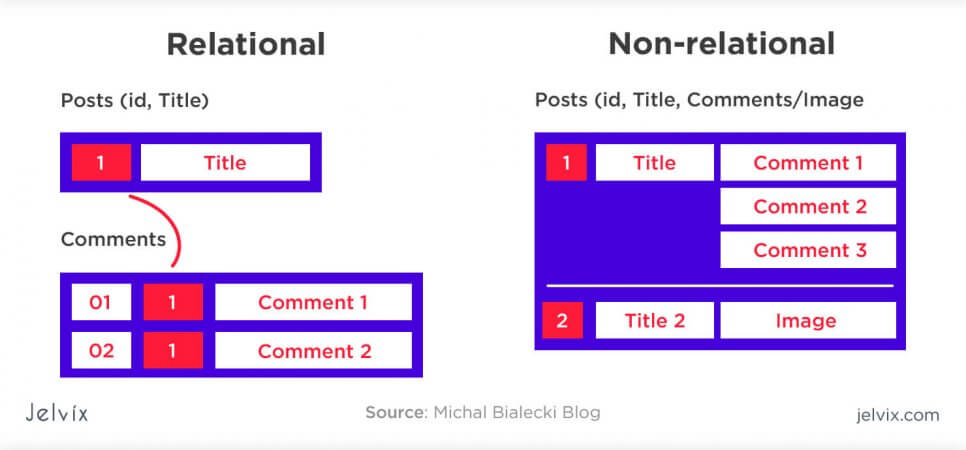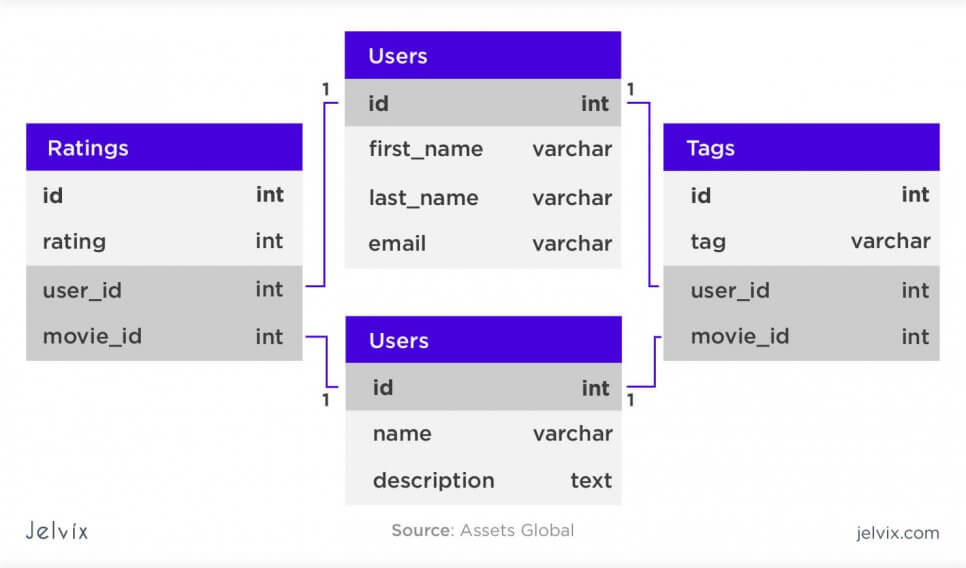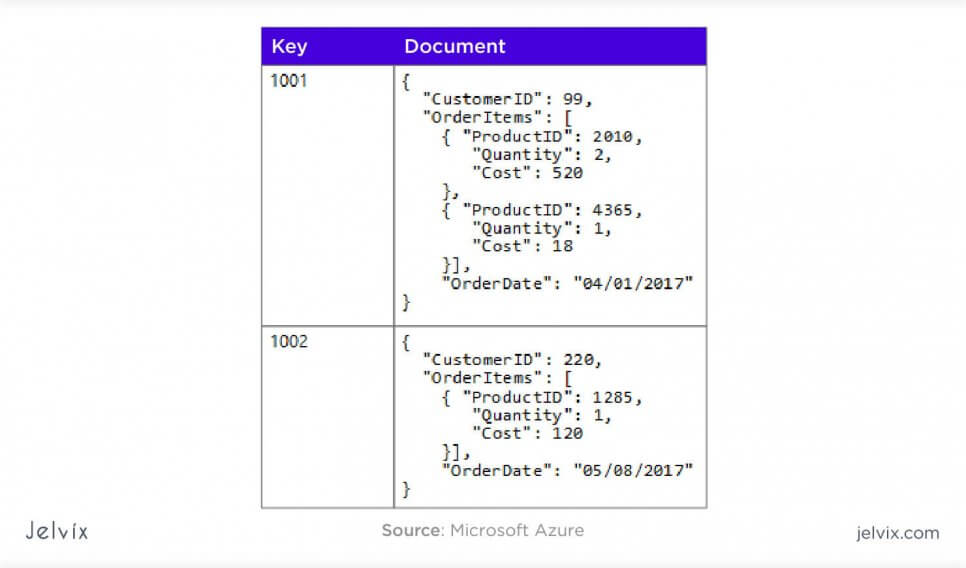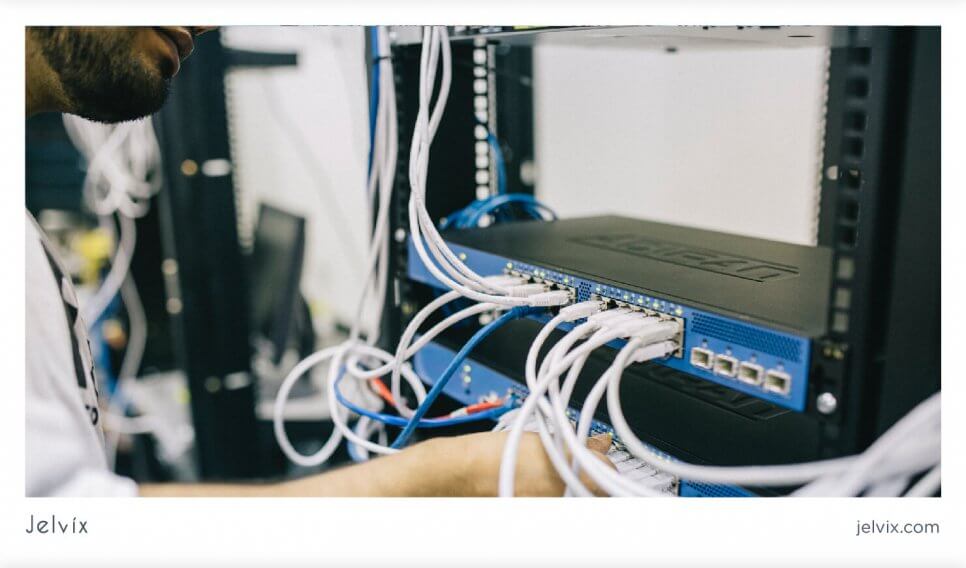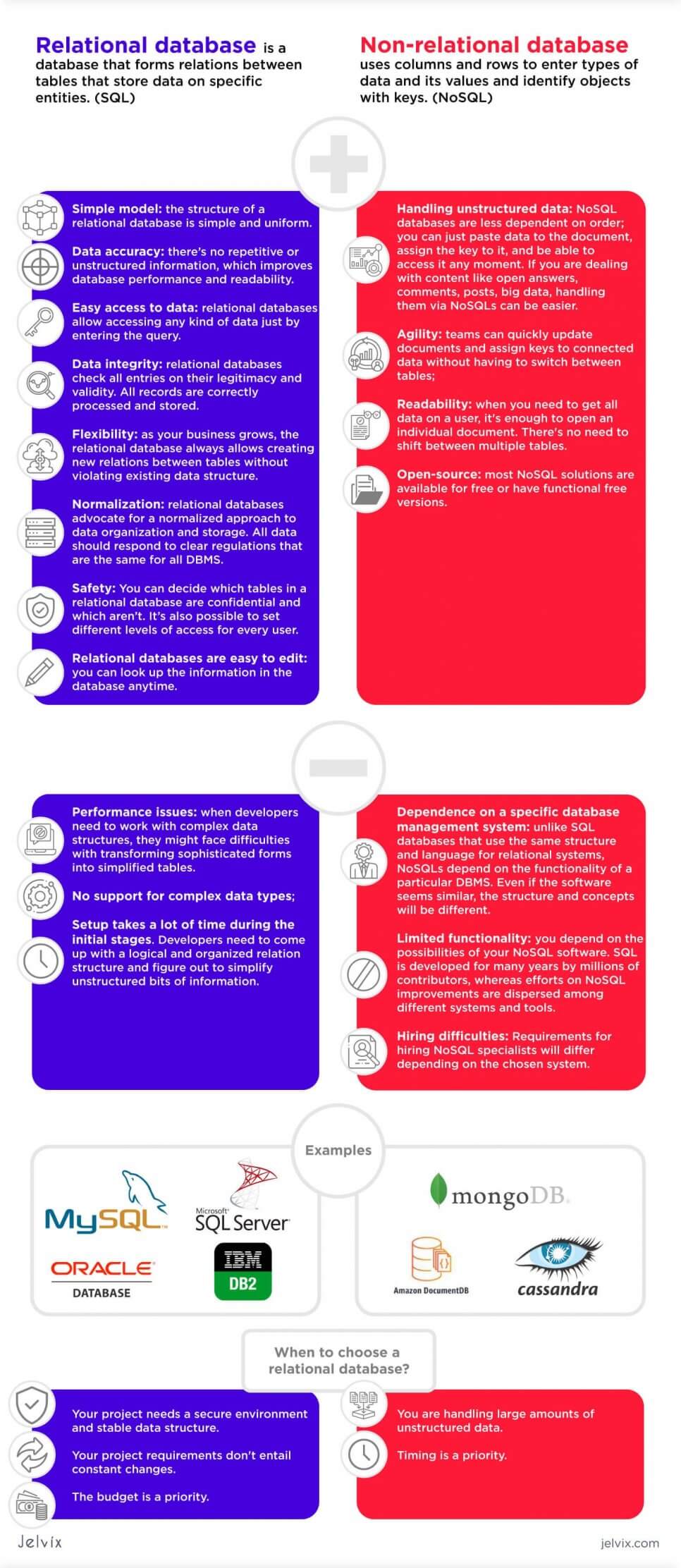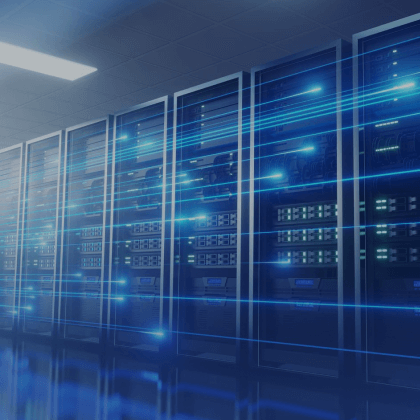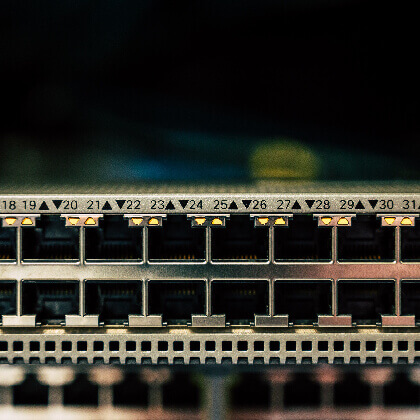The database is a crucial element of the web application. Information that users input into the website, personal data, contact info – all these bits are stored into a database. Its security, performance quality, and versatility are crucial for the website’s smooth functionality.
There are two main types of databases used in web development: relational and non-relational. The main difference between the two is a type of used structure.
- Relational databases use tables that are all connected to each other.
- Non-relational databases, on the other hand, are document-oriented. Unlike tables, which are responsible for a single type of data, they can store information under different categories, which all depend on different commands.
Let’s take a deeper look at relational database vs. non-relational one, and work through their main principles and structure.
What’s a relational database
Relational databases store information with columns, rows, and tables. Each column accommodates a data point (a category of information that will be stored), and a row represents the value for that category.
Each table can store data only for one object. You can’t store data on customers and clients in the same relational table. For the database to work, a relational database requires two tables: one for customers, another one for clients.
When an additional detail is added to a table, a new table is created. Then, connected tables form relationships. This is where the name of the database type is derived from.
Keys of relational tables
Each table of the database has a specific key that identifies the data in the table. To connect one table to another, foreign keys are used. A foreign key is then connected to a primary key.
So, a relational database is a database that forms relations between tables that store data on specific entities. A relational database uses Structured Query Language.
What’s a non-relational database?
Relational versus non-relational databases are more flexible because the data on the object isn’t limited to the same table. Non-relational databases use columns and rows to enter types of data and its values and identify objects with keys.
For instance, if you need to remember the customer’s logic, you identify the object (customer) with a key and assign data to it. Now, whenever you need to assign new information to the same customer, you just have to enter a specific key. There’s no reason to look and edit a particular table – the database will automatically structure the information.
Obviously, this approach is more intuitive and flexible, but it doesn’t come without drawbacks. NoSQL databases often lack organization and are harder to process as documents become bigger.
Comparison of relational versus non-relational databases
So, the key theme emerges: relational databases emphasize structure, whereas non-relational databases prioritize flexibility. This already gives us a basic insight on which types of projects will fit better to each of these – but we’ll get to this later on. For now, let’s focus on the main general advantages and disadvantages of each database type.
Advantages of a relational database
Relational databases proved their efficiency over time. Developers appreciate their clear organization, normalization, and clear requirements to entered data. Let’s take a closer look at the practical advantages of relational databases.
- Simple model: The structure of a relational database is simple and uniform. It’s enough to know the main SQL queries to input, search, and manage data. You don’t need to know complex architectural processes. The core principles of the database are uniform and independent from a particular tool, which not at all the case for non-relational databases.
- Data accuracy: In relational databases, developers carefully sort through every piece of data. There’s no repetitive or unstructured information, which improves database performance and readability. Primary and foreign keys are intuitive ways of connecting and identifying databases, which also contribute to high accuracy.
- Easy access to data: Relational databases allow accessing any kind of data just by entering the query. With conditional statements and queries, you can view any number of related tables. There’s no specific pathway for data search and management. As soon as you found the piece of information via a query, you can edit it on the spot – no special pattern required.
- Data integrity: Relational databases check all entries on their legitimacy and validity. All records are correctly processed and stored. As soon as the database detected an isolated entry, developers are immediately notified. Errors don’t accumulate over time, which makes relational databases well-suited for scaling solutions.
- Flexibility: Although it’s true that relational databases require more attention to details (because you are supposed to structure information properly in order to store it), in the end, it pays off with increased flexibility. As your business grows, the relational database always allows creating new relations between tables without violating existing data structure. Also, it allows no duplicates, which limits CPU consumption and increases database efficiency.
- Normalization: Relational databases advocate for a normalized approach to data organization and storage. All data should respond to clear regulations that are the same for all DBMS. SQL uses the same principles to break down data – all information that doesn’t fit these criteria won’t be stored. At first, this seems to be a limiting factor. You will constantly get notifications about data errors and duplications, which can make the development process longer at first. However, as the project grows, teams appreciate the orderly, error-free structure of non-relational databases.
- Safety: You can decide which tables in a relational database are confidential and which aren’t. It’s also possible to set different levels of access for every user. The settings of one table won’t necessarily attract the others. You can decide which data and relationships comply with strict confidentiality rules.
- Relational databases are easy to edit: You can look up the information in the database anytime. It’s enough to look for a piece of data to see the entire table and all related bits of information. You can set up conditions for table relations, modifications, and safety. Each condition can be edited standalone without affecting the entire system.
Disadvantages of relational database
- Performance issues: when developers need to work with complex data structures, they might face difficulties with transforming sophisticated forms into simplified tables.
- No support for complex data types;
- Setup takes a lot of time during the initial stages. Developers need to come up with a logical and organized relation structure and figure out to simplify unstructured bits of information.
The main reasons to use a relational database are safety, absence of duplication, and data integrity. Sure enough, you need to pay attention to many details, establish the right connections between all the tables, and maintain the structure intact. But ultimately, this is what gives origin to the main strengths of relational databases – consistency, ACID compliance, and efficiency.
Advantages of a non-relational database
- Handling unstructured data: NoSQL databases are less dependent on order; you can just paste data to the document, assign the key to it, and be able to access it any moment. If you are dealing with content like open answers, comments, posts, big data, handling them via NoSQLs can be easier.
- Agility: teams can quickly update documents and assign keys to connected data without having to switch between tables;
- Readability: when you need to get all data on a user, it’s enough to open an individual document. There’s no need to shift between multiple tables.
- Open-source: most NoSQL solutions are available for free or have functional free versions.
Disadvantages of a non-relational database
- Dependence on a specific database management system: unlike SQL databases that use the same structure and language for relational systems, NoSQLs depend on the functionality of a particular DBMS. Even if the software seems similar, the structure and concepts will be different. If you switch from one DBMS to another, you’ll have to rewrite most of the code from scratch.
- Limited functionality: again, you depend on the possibilities of your NoSQL software. SQL is developed for many years by millions of contributors, whereas efforts on NoSQL improvements are dispersed among different systems and tools. As a result, you’ll be getting a lot fewer additional features and customization options.
- Hiring difficulties. Requirements for hiring NoSQL specialists will differ depending on the chosen system. You’ll have to look for a professional in a specific tool (for instance, MongoDB), not just a generic NoSQL specialist.
NoSQL solutions are mostly younger than SQL software, which is why its functionality and interface are less mature. On the other hand, non-relational databases make up for this drawback by offering an easier sharing process (you can easily exchange documents between systems without worrying about damaging structural relations). The factor of maturity, therefore, should definitely be taken into account when you choose between a relational database vs non-relational database.
Examples of relational databases
Most database software has rich SQL functionality, from desktop tools to massive Cloud platforms. Let’s take a look at the examples of the most popular SQL tools and see which functionality.
MySQL
MySQL is an open-source tool for relational database management, which is used as a part of the LAMP web stack (the abbreviation is the shortened version of Linux, Apache, MySQL, Perl/PHP/Python). MySQL is used by many content management systems, including WordPress, Drupal, Joomla, phpBB, and is perhaps the most popular relational database example. This database management solution is used by Youtube, Flickr, Twitter.
Functionality
- SQL and NoSQL support: MySQL supports both relational and non-relational databases (even though it’s mostly used for SQL queries);
- Cross-platform solution: MySQL supports Linux, Windows, Mac OS, and others;
- Performance monitoring: you can track resource consumption and application performance with Performance Schema.
- Password encryption: MySQL has a powerful security layer;
- Client/ Server Architecture: MySQL allows applications to communicate with servers, save updates, and query data.
- Performance: MySQL can process up to 50 million data rows. The size of the project can go to as much as 8 data terabytes.
Disadvantages
- Slow data transaction: when a project grows, MYSQL operations tend to slow down significantly;
- Weak debugging algorithms: MySQL doesn’t have a powerful development toolkit.
Microsoft SQL Server
MS SQL Server allows managing a relational database, working with local queries, tables. It’s one of the most famous relational database management systems that is supported by many Cloud services and development tools.
The software offers all benefits of a relational database, plus unique features. You can work with constraints, foreign and primary keys, stored functions, temporary objects, users, types, server migration functionality, indexes, and many other essential features of a relational database. Let’s take a deeper look at its functionality.
Functionality
- In-memory analytics: it’s possible to do operations with queries and analytics with the RAM data;
- BI Semantic Model: an improved bigger-picture view of the data sources and connections;
- Customization: users can edit types of mappings and rename data objects;
- Documentation migration: Microsoft SQL server-generated reports about server migration;
- Integration with oracle databases: the software transforms triggers and features into Oracle SQL, generates automated DDL scripts.
- Error management: Microsoft SQL service collects information about data input and migration errors.
Disadvantages
- Expensive licensing plans: any business use falls under a licensing fee. An SQL Standard edition costs $7,171 for a processor. An improved version, the SQL Server Datacenter, costs $54, 990.
- Windows-based servers only: Microsoft SQL only works on Windows servers, neglecting Unix support. Many of Microsoft’s competitors run on other platforms, including Linux and Mac. Also, if you are using apps that run on other systems, you can have difficulties integrating these solutions with a Windows-only database.
Oracle Database
Oracle hosted its database in the Cloud and used to transition to Cloud computing and run Cloud computing for web projects. Users don’t have to pay for servers, and this is the responsibility of the company.
Functionality
- Transaction isolation: Oracle allows defining four levels of data transaction protection. Users can choose between a dirty, unrepeatable, and phantom read.
- Grouped transactions: Oracle allows running similar data only. Unlike Microsoft SQL, for instance, that only allows running one dataset at a time, Oracle supports batch transactions. Obviously, this contributes to faster performance and a better end-user experience.
- Real Application Cluster: The application allows connecting many servers to the same database to concentrate computing power on the same task. With a Real Application Cluster, you can include a new server into your payment plan and boost the efficiency of database performance 2-3 times.
- Multi-OS support: Oracle SQL is supported by Unix servers, which is a security advantage because Unix servers are less prone to security threats. Also, you can upgrade your database anytime and exchange data between systems.
Disadvantages
- Price: Oracle SQL has high licensing fees: for a single unit (sockets, core factor, core per sockets), you need to pay $47,500 per unit.
- Finding an Oracle database development team: Oracle has its own specific way of approaching SQL. A lot of features don’t fall under common standards of the best development practices: you need to know Oracle-specific features and rules. Finding a skilled team in such a narrow niche can be a challenge.
- Difficult to learn and use: Oracle’s versatile functionality comes at the cost of high-level of difficulty. Oracle SQL is not user friendly, and you don’t have as many ready database templates.
IBM DB2
IBM’s DB2 is one of the oldest and most mature relational database solutions on the market. Let’s take a look at its key functionality that provides it a competitive edge compared to Oracle, Microsoft SQL Server, and MySQL.
Functionality
- A powerful SQL modification: compared to many other relational database management systems, DB2 uses a more efficient SQL dialect. The service supports object tables, Java methods, arrays, and user-defined functions. Its version of SQL allows adding data directly to the code in Java and COBOL. This feature makes DB2 very flexible for many web projects.
- Efficient memory handling: DB2 doesn’t require database administrators to configure application memory automatically. Self-tuning memory of DB2, implemented in the 9th update, makes automatic changes in the workload, switching processing to batch modality, setting up data allocation, and optimizing performance.
- Support of IBM infrastructure. If you use other IBM software and hardware, you’ll be able to use integrations, updates, and patches.
Disadvantages
- A lot of necessary add-ons: IBM by default doesn’t offer access to entire DB2 infrastructure. You will need to connect the database management system to other IBM tools to unlock its full functionality.
- The free IBM support is only available for the first three years; then it becomes paid.
Examples of non-relational databases
Non-relational software got popular due to its ability to handle large masses of data in an intuitive way. This is very useful for peer-to-peer and community platforms, social media, and messengers. Many products that involve constant processing of multiple user data are developed exactly with non-relational database management systems. Let’s take a look at the most common solutions and see their advantages and drawbacks in default.
MongoDB
This is the most popular non-relational database example. The website refused the traditional relational model and didn’t use rows and columns. Instead, you have an entire document for one data object – and you can link two documents with keys. Let’s take a look at features that made MongoDB’s reputation as one of the best modern database management systems.
Functionality
- Support of various data types: MongoDB allows storing all kinds of data in the same type of document. Sure, this database won’t be structured, but on the other hand, you don’t have to waste time on processing collected data.
- Auto-sharding: MongoDB allows distributing data automatically between different servers.
- Fast performance: according to official statistics, MongoDb works about 100 times faster than a relational database. It’s also one of the fastest options among fellow relational solutions.
- Tech support: unlike IMB DB2, which limits its free support plan to 3 years, this database doesn’t revoke support services from its clients.
Disadvantages
- MongoDB needs to store keys for every created documents. As the size and number of documents grows, the database management system requires more memory increasingly.
- No control of duplication: you can always add a new entry to the document, even if you added an identical one before. As long as you assign it a different key, you’ll never know that the fragment is duplicated.
- Lack of documentation: MongoDB lacks wiki files and free educational files, especially compared to older relational database management systems. Among non-relational tools, however, it’s one of the most available ones.
DocumentDB
It’s a modern database management system managed and developed by Amazon. The database service can be integrated with MongoDB – you can create JSON documents from scratch or transfer them from another base.
The main purpose of the database is to allow working with high MongoDB workloads. You can set up the server performance, manage millions of requests, use low-latency functionality, and manage data of all sizes.
Functionality
- Compatibility with MongoDB. The functionality and interface of Documentdb are similar to those offered by Mango – users who switched from one tool to another don’t feel much difference. Moreover, it’s possible to integrate native MongoDB APIs to use identical functionality.
- Database migration: clients can transfer their databases for free for six months.
- Monitoring: Amazon offers metrics for memory, query output, compute, storage, and active connections.
- Automatic updates: the software will install the latest patches automatically. The versions of the system can be managed via Database Engine Version Management.
- Automatic storage increases: as the size of the database increases. Amazon DocumentDB will automatically supply more storage space in the Cloud.
Disadvantages
Amazon Documentdb is very similar to MongoDB, so it also shares the same drawbacks. There’s also no control of duplication, scarce educational resources, and the database isn’t organized well. It’s possible that as your project scales, documents will become a lot messier.
Cassandra
Casandra is an open-source non-relational database, based on Amazon tools and Google’s Bigtable data models. The software was created by the Facebook team and is currently used by Twitter, Netflix, eBay, Cisco, Facebook, and others.
Functionality
- Scalability: Cassandra supports changes in hardware and servers (you need to pay for all additional computing capacities, though);
- Support of unstructured, structured, and semi-structured data: the software can automatically switch between these modes;
- Support for multiple data centers.
Disadvantages
- No ACID support and Aggregates support;
- Latency problems: Cassandra is not good at reading high volumes of data simultaneously.
Use cases for relational vs non-relational DB
All types of databases can be used for many types of projects – there’s no strict distinction when one should be preferred over the other. However, you can make an informed choice by analyzing certain aspects of your project beforehand.
Use cases for relational databases:
- Your project needs a secure environment. Relational databases take more time to set up and manage, but in exchange, they offer data atomicity, consistency, isolation, and durability, also known as ACID. It’s a good choice for projects in finance, healthcare, e-commerce. Any type of project where you handle financial transactions and confidential data can benefit from ACID principles.
- A stable data structure. If your project requirements don’t entail constant changes, in-app functionality, and processing algorithms, a relational database will provide a stable, secure environment for data management. Then, you will not feel as much the lack of SQL’s flexibility – because your app doesn’t require it.
- The budget is a priority. Finding an SQL development team is generally cheaper because there are more qualified specialists to choose from. All SQL tools follow the same principles, whereas non-relational database functionality is specific to a particular tool.
Use cases for non-relational databases:
- Timing is a priority. No-SQL databases are faster to set up, and data entering requires a lot less methodical approach. You can paste unstructured data in the document, assign a key, and deal with an organization later. It’s a good idea for MVP development and urgent software releases.
- You are handling large amounts of unstructured data. If you are working on a social media app or building a community marketplace, you need a tool that can accommodate the personal information of millions of users. A lot of this data won’t be structured (profiles descriptions, Feed updates, etc.) – so the regular column-row model will be harder to set up and slower to run.
These are obviously general distinctions – in reality, there are exceptions to each rule. However, the rule of thumb is, if you prioritize stability over flexibility, go for SQL-based systems. If, however, you handle large amounts of unstructured information, non-relational databases are your best bet.
Questions to ask yourself before choosing a database type
Finally, to make this choice even easier for you, we prepared a checklist. Ask your team and yourself these questions before committing to a single solution.
What type of data will you be analyzing?
If you are working with a lot of factual and numeric data, the SQL database will be a good bet. Numbers and structured text are easy to organize in tables, and you’ll have a clear structure of your data model.
However, if your application is handling a large amount of “messy” data, you need to pick a flexible solution that doesn’t prioritize structure over performance speed. If you try to organize these bits of data, it will take a lot of time, and ultimately you’ll end up with an unintuitive monolithic database.
How much data are you dealing with?
If you are dealing with huge amounts of data (like in social media websites or community-based marketplaces), a non-relational database is a better choice. You’ll be able to add new information a lot faster.
What kind of resources can you devote to the setup and maintenance of your database?
If you are ready to invest time and budget in the setup of your database early on on the project, you can choose an SQL solution. It’s harder to set up, but later on, it pays off with a clear structure and human resources availability The main advantage of SQL solutions here is that teams are a lot easier to come by.
Non-relational databases, on the contrary, are easier to set up, but when it comes to long-term support, you need to be sure that you have a reliable vendor. Finding another MongoDB or Cassandra team can be challenging.
Do you need real-time data?
If you are working with real-time data, NoSQL databases will provide you more flexibility and save a lot of time on the input stage.
Conclusions
The choice between relational and non-relational databases depends on your project’s priorities and team skills. SQL databases are tried and proven, SQL as a language has been contributed to for years and by many systems. It’s a go-to choice for the high-level organization and reliable security. Additionally, SQL professionals are easier to come by because their experience is valid for any tools – they aren’t tied to a single platform.
NoSQL databases, on the other hand, are more flexible. Pasting all information on the object in the single document contributes to a higher speed, intuitive, and readability. You don’t have to think about how to set up connections between different tables or break unstructured data down so it can fit rows and columns. However, you need to look for a team that’s proficient in a particular system – and should you migrate to a new solution, you’ll have to change developers as well.
Our Jevlix database experts can help you make a choice between SQL and No-SQL. We’ll take a look at your project, structure product requirements, show our projects and explain why we chose particular databases. Contact our team to get an expert consulting and choose the best database for your software.


